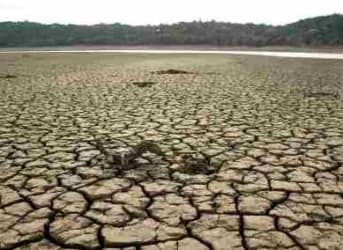California has just entered its fourth year of drought -- a slow-rolling crisis that is showing no signs of abating.
All of California is now affected, with more than half of the state considered to be in “exceptional” drought, the worst designation handed out by the U.S. Drought Monitor.
Reduced rainfall means that California reservoirs are continuing to shrink, with water levels at just 52 percent of their historic average.
That’s not just a problem for California’s $42.5 billion agricultural industry, which grows and produces much of the country’s fruits, nuts and vegetables. It is also is cutting into the state’s electricity generation.
Related: Fed Up With Federal Inaction, States Act Alone on Cap-and-Trade
That’s because California sources a significant portion of its electricity generation from hydropower, so less precipitation means less electricity. Before the drought, California routinely generated about 20 percent of its electricity from hydropower during the period of January through June. But for the first six months of 2014, according to the U.S. Energy information Administration (EIA), that productivity has been slashed in half, to just 10 percent.
To make up for the shortfall, California’s renewable energy industry has picked up some of the slack. Wind now accounts for more electricity generation than hydro – in part because of the drought, but also because of greater installed wind capacity. Solar, too, is making a big contribution. On clear sunny days, by midafternoon, solar can supply the state with 14 percent of its power needs.
But California has also needed to rely much more heavily on natural gas to cover for lost hydro. From January through June of this year, natural gas power plants were generating 16 percent more electricity than average.
This wouldn’t be necessarily be a problem if California didn’t have ambitious plans to reduce its greenhouse gas emissions. Replacing clean hydropower with more natural gas can lead to a spike in the wrong direction.
Complicating matters further is the closure of the San Onofre nuclear power plant. When the plant closed, California lost about 18 billion kilowatt-hours of carbon-free electricity. As Forbes notes, the electricity from that one plant is equal to all of the solar and wind in the state combined. With the plant offline, the state lost a lot of ground on its journey towards a low-carbon future.
On the other hand, California’s own law requires it to reduce its greenhouse gas emissions to 1990 levels by 2020. So despite the setbacks from drought and the shuttered nuclear power plant, one way or another, California has legally bound itself to meet that target.
Related: California’s Progressive, Divisive Cap and Trade Plan
That means that it will have to redouble its efforts at energy efficiency and renewable energy. California’s Renewable Portfolio Standard (RPS) will help it get there. It requires utilities to generate 33 percent of their electricity from renewable sources, including solar, wind, geothermal, biomass, and small-hydro. The state is making a lot of progress -- in 2013, it generated 22 percent of its electricity from renewables.
The cap-and-trade program will also force a lot of clean energy and energy efficiency into the market. Capping emissions from large generators and requiring them to reduce their emissions or purchase offsets will incentivize more renewable energy. And beginning in January 2015, California’s transportation sector will be included in the cap-and-trade program, a potentially huge change that could increase gasoline prices and push drivers towards fuel efficient vehicles.
California has always been at the forefront of environmental policy. But it remains to be seen if the state can hit its ambitious renewable energy targets. For now, California’s epic drought, coupled with the closure of the San Onofre nuclear power plant, will make the challenge much more difficult.
By Nick Cunningham of Oilprice.com
More Top Reads From Oilprice.com:
- Congress Considers Federal Assistance For Laid-Off Coal Miners
- Climate Change Deniers Are Having A Very Bad Year
- Despite Rising Voice of Climate Movement, Global Leaders Dither


















